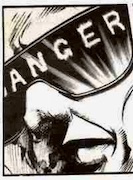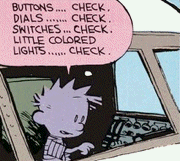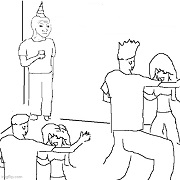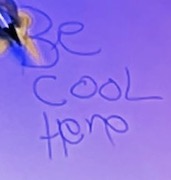|
I’m officially America’s newest 767 pilot.
|
|
|
|

|
| # ? May 19, 2024 22:42 |
|
Goongrats!
|
|
|
|
e.pilot posted:I’m officially America’s newest 767 pilot. Congrats! I read back a clearance today and it was so bad the controller said "that's not even *remotely* what I said!" so I'm doing pretty great too  I wish it had been one of my under-confident students with me at the time, because I'm really trying to drive home the lesson with them that loving up, even in a ridiculous way, isn't the end of the world, it's catching and fixing it that's important. EDIT: Especially the dude who always keeps coming up with excuses for why he made a mistake. No, you didn't make a mistake because the controller had the mic too close to his mouth or the wind was gusting or whatever the gently caress, you made a mistake because we are all humans who fall well short of perfection, and sometimes we just need to admit our mistakes and deal with them. PT6A fucked around with this message at 05:45 on Apr 8, 2019 |
|
|
|
ausgezeichnet posted:The same guy who dumps the lav would be tasked with filling the LOX tank, so I'm not on board with this. Finally, something that will remove blue-water stains.
|
|
|
|
PT6A posted:
Yikes.
|
|
|
|
Hopefully it’ll make the flight instructors feel better to learn that ATC developmentals have that same mentality not infrequently. It’s literally any reason except “whoops I hosed up.” We have one now, in fact.
|
|
|
|
The day I stop saying stupid poo poo on the radio is the day I’m no longer a pilot.
|
|
|
|
Any 737/A32x drivers in here? Somethings been pissing me off recently. We’re the first two center sectors that talk to our traffic flows, and it seems like a significant chunk (maybe as much as half) of these two types reject their filed altitude when you give it to them. IE, SWA123 files for FL400, but when I issue it, he says “uhhhh, Center, we cant make forty, can we request FL380?” I know requested is probably generated by dispatch, but do they just completely ignore ambient temperature when they generate flight plans? Are they using one temperature for their entire region or something equally stupid? This seems petty, but when you’re busy, it gets real old having half your traffic take three or four calls instead of just one and a readback to issue an altitude.
|
|
|
|
Lots of factors at play here. My companies dispatchers tend to file us too high and it’s company policy to file us as high as we can go unless there’s something else going on like bad rides or high headwinds. The dispatching software we have will say the airplane can get that high but some airplanes are different than others so you might not make it. Usually we’re looking at the FMC to tell us what our optimum and max altitudes are and that’s taken directly from the air data computer and not based on some forecast hours ago. Sometimes it boils down to pilot preference. There’s a not insignificant group of pilots that start getting real antsy when we’re filed in the upper 30s and low 40s. Not sure why really.
|
|
|
|
MrYenko posted:Any 737/A32x drivers in here? Somethings been pissing me off recently. I'm 13 years removed from the airline realm, but if I had to guess it would be late tankering of fuel or ignoring the effects of non-standard temps. Which is stupid, because the flight planning services all have the ability to compute performance based on temps deviating from ISA. Knowing the way SWA operates, their dispatchers probably have a smudged and coffee-stained cruise performance spaghetti chart they pass around to each other in Dallas.
|
|
|
|
Jealous Cow posted:Yikes. Yeah, it's extremely difficult to teach someone who thinks that all mistakes come from somewhere other than themselves. Mistakes will happen, to students and to the rest of us, and I don't know how to get through to this guy that, for example, landing halfway to the side of the runway didn't just happen because there was a weird crosswind gust, it happened because there was a weird crosswind gust and then you didn't react to it or there was a gust that destabilized the approach to an unacceptable degree and then you didn't pull up and go around. Or, hell, maybe ATC did give you a weird, unclear instruction -- it happens -- but if you just acknowledge it without a readback and/or understanding it, it's then on you when something goes wrong. One time he even used the example of another plane doing something wrong, to excuse why he did something completely different wrong. "See? He didn't understand what the controller was saying either!" Well, except that I was in the plane at the time, I heard exactly what happened, and another of my students was solo in that other plane, and we had a discussion about what went wrong and how to avoid it in the future. So, I'd send that other student solo again knowing he wouldn't make the same mistake twice. The excuses guy? Not a chance at this point. This dude is a case study in human factors.
|
|
|
|
If it’s a shorter flight there might just be no reason to climb that high. Our dispatch was notorious for doing that when I was flying CRJs. A 45 min flight doesn’t need to be flown at FL330, you’ll level off just in time to start descending.
|
|
|
|
PT6A posted:Yeah, it's extremely difficult to teach someone who thinks that all mistakes come from somewhere other than themselves. Mistakes will happen, to students and to the rest of us, and I don't know how to get through to this guy that, for example, landing halfway to the side of the runway didn't just happen because there was a weird crosswind gust, it happened because there was a weird crosswind gust and then you didn't react to it or there was a gust that destabilized the approach to an unacceptable degree and then you didn't pull up and go around. Or, hell, maybe ATC did give you a weird, unclear instruction -- it happens -- but if you just acknowledge it without a readback and/or understanding it, it's then on you when something goes wrong. Yeah that dude is gonna be the next Jerry if he gets his ticket.
|
|
|
|
PT6A posted:Yeah, it's extremely difficult to teach someone who thinks that all mistakes come from somewhere other than themselves. Mistakes will happen, to students and to the rest of us, and I don't know how to get through to this guy that, for example, landing halfway to the side of the runway didn't just happen because there was a weird crosswind gust, it happened because there was a weird crosswind gust and then you didn't react to it or there was a gust that destabilized the approach to an unacceptable degree and then you didn't pull up and go around. Or, hell, maybe ATC did give you a weird, unclear instruction -- it happens -- but if you just acknowledge it without a readback and/or understanding it, it's then on you when something goes wrong. In other news I finally crossed the 100 flight hours mark and bungled an untowered airfield call coming in on a circle to land approach!
|
|
|
|
cigaw posted:We had a student recently get kicked out of the program at my location for failing multiple evals, in no small part due to never accepting fault for anything that ever went wrong. Never holding yourself accountable is a terrible attitude to have. I no poo poo know people who have passed checkrides despite items that were technically below standard, because they were honest about the fact they did it poorly when asked, and identified what mistakes they made. Those people probably aren't going to do something stupid and die because they did a poor steep turn under the pressure of a flight test one time or whatever; someone who has no insight into their own proficiency is a different matter.
|
|
|
|
MrYenko posted:Finally, something that will remove blue-water stains. Man SPEAKING of lav service. Major dick move from me yesterday. I was using the plane toilet before post flighting and as soon as I started peeing I heard the *chunk* of them unhooking the hose. I didn’t realize the other guy already had them hook up and drain it. Got to go grab him and be like “dude you’re not done yet lol sorry.”
|
|
|
|
Boeing seems to be a tangled mess of problems https://www.nytimes.com/2019/04/08/business/boeing-737-max-.html I don't see the max line surviving much longer, even if it flies perfectly from here on out this is just like Concorde levels of bad PR
|
|
|
|
|
Boeing has over 5,000 orders for the Max. It is too big to fail.
|
|
|
Two Kings posted:Boeing has over 5,000 orders for the Max. It is too big to fail. Yeah that's sort of always the problem isn't it?
|
|
|
|
|
And it's not like an airline can go and say, "gently caress you Boeing we're buying A320s instead!" because Airbus have a backlog for the A320neo that's even larger than Boeing has for the 737 MAX.
|
|
|
|
*Delta laughs in MadDog*
|
|
|
|
I'm of the view that consumers will stop caring when all the agencies say it's good to fly again, which will happen eventually because the basic engineering issue is solvable in principle, even if it's not elegant. It may accelerate Boeing's timetable for the replacement. Meanwhile Boeing will lose a bunch of money but easily remain in business.
|
|
|
|
Meanwhile, in China, there is an executive who is suddenly turgid about the prospect of selling C919s to someone other than Chinese airlines. And Cubana is saying, "You laughed when we bought the Tu-204, BUT WHO'S LAUGHING NOW?!" (ignoring, of course, their grounded An-158s)
PT6A fucked around with this message at 03:47 on Apr 10, 2019 |
|
|
|
I did a check-on-type with a 737 FO who wanted to be able to rent our Cessnas on occasion, and it turns out he actually reviewed procedures for the 172 and took advice on the differences between flying something like a 737 under IFR continuously, and flying a Cessna VFR. And then today I got asked to book a checkout for one of our renters who hosed up with ATC instructions last month, and he actually admitted fault and came up with a list of things he'd like to work on! Two days of dealing with people who don't have their heads entirely up their rear end in a row? I'm getting spoiled here! On another topic: am I right in saying that 50 hours spent on a loooong cross-country are better in terms of building real world experience and risk assessment skills than 200 hours spent mainly in the circuit and going to the local practice area? Our dispatcher who went to Orlando and back is catching some poo poo from other instructors for being "overconfident," but, hey, he said he was going to do it, and he did it, safely. I think he deserves a little bit more respect for that at 120 total time than some of fresh instructors who rolled in at 300TT (like I did, to be honest) and have never been out of province. And he still recognizes that he has a lot to learn and he's not god's gift to flying, so in my mind that puts him well ahead of the instructors who think the sun shines out their arse on the basis of 1000TT spent mostly in the circuit or practice area.
|
|
|
|
I mean I flew from Florida to California in about 20 hours at 150 TT, and I feel like I definitely learned a lot having to actually look at and plan around larger scale weather systems. It was the first time I had to seriously look at the prog and SIGWX charts, really sit down and set (and follow!) a set of minimums in the face of get-there-itis, and do route & fuel planning more advanced than "did the flight school fill the tanks before I showed up today."
|
|
|
|
Outside of training for ratings, time in the practice area and pattern are next to useless for actual CRM and aeronautical decision making experience. ymmv
|
|
|
|
e.pilot posted:Outside of training for ratings, time in the practice area and pattern are next to useless for actual CRM and aeronautical decision making experience. Nah, that's exactly how I feel, and though I feel the past few hundred hours have improved my skill as an instructor, I doubt it's made me a particularly better pilot overall. And, for what it's worth, I think instructors get a bit too high on their own supply: it's a gently caress sight easier to sit in the right seat in VMC criticizing a student's mistakes on an ILS approach than it is to shoot one yourself under the hood or in IMC. I just can't shake the feeling that my co-workers, and probably me too, need to be a good bit more humble than we are about a lot of the poo poo we do. Most of us are in the Killing Zone too, just the same as anyone else, and we need to be as ruthless with our assessment of our own flying technique, and instructional technique, as we are of any student.
|
|
|
|
I hear that. I got hired at a check hauler at 1200 hours, had a thousand dual given and thought I was king poo poo. Turns out, like John snow, I knew nothing. Getting trained in and then flying a baron by yourself through all the Midwest can throw at you for a couple years teaches you a lot.
|
|
|
|
I’m at 2400 hours with all of my instructor ratings, mostly turbine time, two type ratings, and still feel like I don’t know poo poo. 
|
|
|
|
e.pilot posted:I’m at 2400 hours with all of my instructor ratings, mostly turbine time, two type ratings, and still feel like I don’t know poo poo. LOL meet you at the St Michael’s in Hahn, Germany layover. We are gonna drink a LOT of beer. And bitch about contracts. Doesn’t make sense? It will... soon.
|
|
|
|
Animal posted:LOL meet you at the St Michael’s in Hahn, Germany layover.
|
|
|
|
Hey pilot goons Wondering if anyone can weigh in on my situation, or at least tell if it is hopeless. I'm just over 22 hours, have yet to solo. My ability to fly the plane is pretty good, I'm making nice stable approaches most of the time and nailing airspeeds, and then I balloon out and porpoise on the roundout. There's an occasional bounce and the occasional landing where my CFI doesn't have to touch a thing. I've read things, I've watched youtube things, I've had the last 7 hours in the pattern, and spent an hour in the sim to work on the sight picture. The instructors say it'll come, but I am burning through the budget for this and getting discouraged.
|
|
|
|
yellowD posted:Hey pilot goons My guess: when you raise the nose, you're targeting the visual landing attitude and trying to reach it without regard for your airspeed. (I saw you noted that you're being accurate about your speed, but that's on final and I'm talking about during the roundout/flare here.) Keep in mind that lift is the product of AOA and airspeed. During the flare, you want an essentially level flight path, which necessitates constant lift (= weight). Since the airspeed bleeds down at its own rate that you have no control over, this requires that you increase the AOA at that rate that is dictated by the airspeed bleed rate. Not too slow, not too fast. If you go to set the landing attitude "now," (my guess as to what you're doing) you're setting an AOA higher than what it takes to match the airspeed for that instant, and lift exceeds weight so you balloon. If there that's the case, what you need to do when you start the roundout is to not think about the landing attitude, but rather think about your height over the ground. Simply, you have to get your main wheels closer and closer to the ground but not go up. Essentially, try to fly a constant height as you slow down (mains 12 inches above the ground). Simply, if you feel you're about to sink, add some back pressure. If you feel you're about to rise, release some back pressure. These reactions have to be as quick as possible and as small as possible. (If you're late with them, they'll have to be bigger and you'll overcontrol and PIO.) So, in short, don't fly attitude, fly height. (Premature setting of attitude makes you balloon.) Ignore attitude, and as you slow down at 12 inches AGL for as long as you can, the attitude will reach the correct value anyway without your conscious thought. It's a natural outcome of the slow speed (i.e., high AOA) vessbot fucked around with this message at 18:58 on Apr 11, 2019 |
|
|
|
yellowD posted:Hey pilot goons Smoothly put the top edge of the cowl on the distant end of the runway/horizon and hold it there. e: Also this https://youtu.be/9JfoZERqM7Q
|
|
|
|
e.pilot posted:Smoothly put the top edge of the cowl on the distant end of the runway/horizon and hold it there. But how smoothly? How should he know if his version of "smooth" is too fast or too slow?
|
|
|
|
yellowD posted:Hey pilot goons I don't remember the exact number but I'm pretty sure i solo'd around 28 hours. The ~10 hours leading up to that event sucked and were what felt like a frustrating waste of money and time for several months. Keep at it! There is some advice here and you're already watching youtube and I'm not a CFI or a very good pilot. BUT one thing that helped me get a feel for how the airplane was going to respond in the flare was to try an experimental and tiny bit of back pressure between 50 and 100 feet or at "Treetop height". Just enough to maybe bleed off a little speed but nothing meaningful. What it will do is pick your nose up which will increase drag and your sink rate. Add a touch of power if the sink rate increase is too high, only drop the nose again as a last resort. That action will help you calibrate your actual flare back pressure a few seconds later in addition to helping to set the airplane up for it. I fly an airplane that likes to float (Grumman Tiger) and am very focused on attitude on short final. Allowing the nose to drop and diving into ground effect devours runway, even if the vref speed is acceptable. sanchez fucked around with this message at 16:27 on Apr 11, 2019 |
|
|
|
vessbot posted:My guess: when you raise the nose, you're targeting the visual landing attitude and trying to reach it without regard for your airspeed. (I saw you noted that you're being accurate about your speed, but that's on final and I'm talking about during the roundout/flare here.) Yeah, this is a very good post, I agree that the main problem is focusing too much on the landing sight-picture and not enough on how to reach that sight-picture. I'd just add a few things here: 1) Make sure you're looking outside, down the runway to the end, and use that to judge your height as vessbot describes. That's how you'll be able to tell if you're gaining or losing height, and you'll be able to make those small adjustments as necessary. I'm sure you've been told some variation of "look at the end of the runway," but that's why you're looking at the end of the runway. 2) If you're having hard touchdowns, bounces or porpoising after ballooning, the issue is probably that you're letting the nose drop too much immediately after the balloon to try and cancel out that rise. Try to avoid that as much as possible until you get comfortable making very small adjustments -- instead, if the balloon is too severe and you've gained too much altitude, initiate a go-around. If it's minor, simple hold the nose where it is and wait for that airspeed to bleed off, at which point you'll start descending and you can resume making adjustments to your pitch in order to achieve a smooth touchdown. After the mains touch down, don't release backpressure right away. Hold the yoke and allow the nosewheel to gently touch the ground. If you've established the landing attitude but you're still high over the runway and sinking, you can use a little bit of power to control your descent rate. At this point, you're essentially controlling the airplane in slow flight. You're using pitch to lower your speed until the plane lands, and you can use a touch of power to control descent rate. 3) Consider your landing technique in comparison to takeoff. During takeoff, you want a firm, positive control movement to rotate the plane and get it off the ground into the climb. During landing, you want the opposite: small, continuous corrections to pitch until the landing sight-picture is established and the mains touch down. 4) 7 hours in the circuit may get boring and expensive (let me tell you, as an instructor, days when I have several lessons in the circuit do not spark joy) but I don't think it's particularly abnormal, and soloing in the low 20s total time is probably slightly quicker than average, in my experience. If you feel like you're getting bored, ask to go review slow flight or ask to do a short cross-country to another airport and do a few circuits there for a change of pace. It's possibly an unnecessary expense, but a change of scenery should help break some of the monotony. PT6A fucked around with this message at 18:08 on Apr 11, 2019 |
|
|
|
I was exactly the same, didn't solo till 26 hours or so, had the same issues getting frustrated with ballooning all the time, especially as I could tell my instructor was also just as unexcited as I was to spend another sweaty hour or two in the pattern. Honestly, my landings were marginal all the way through my PPL checkride. The biggest thing for me (to emphasize what has been said above), was realizing how subtle and gentle the transition really is. It feels like I used to treat it as a single instantaneous motion, "ok, runway's made, here's my aiming point, NOW" *jerk, balloon*. Going along with that was the almost subconscious idea that I had to touch down as early as possible. I had 5000 feet of runway, but somehow in the back of my mind, I felt like the plane needed to be down by the 1000' markers and off by the second taxiway. It really helped me to think about how much runway I had available, and just trying to see how long I could hold the plane off right above the ground. You wind up in the landing attitude right before touchdown, you definitely don't start there. And, it's definitely a fine motor skill that just takes time and practice for your brain to lock in! Keep at it goon!
|
|
|
|
Wow, thanks everyone. There's a lot here for me to digest and try on Saturday. I definitely get that feeling of 'hit the right attitude before slamming the nose wheel into the ground' which has the added benefit of bringing me close to stall speed. The proper amount of input also kill me. It's super subtle on movements until it isn't, and my brain hasn't made that connection yet. Yesterday's 3kt but 90 degree crosswind was also just enough to to make holding centerline that much more difficult and while endless pattern work gets old I'm the type that would spend 8 hours practicing if cost were no issue since it's all that matters at the moment in the training yellowD fucked around with this message at 19:07 on Apr 11, 2019 |
|
|
|

|
| # ? May 19, 2024 22:42 |
|
yellowD posted:Wow, thanks everyone. There's a lot here for me to digest and try on Saturday. Yeah, it's definitely a muscle memory thing. Like, if I consciously focus on how much I'm moving my hands, or if I'm flying with another experienced pilot and watching their hand movements, it's actually amazing how many tiny little adjustments are being made close to landing, especially in gusty or crosswind conditions. Now, let's talk about crosswind control. This is something I struggled a lot with until about half-way through my CPL. You've probably been taught the sideslip method of correcting for crosswinds during landing, like everyone is. The question comes in: how do we establish the correct amount of sideslip to account for the winds that are present? This hosed with me for a long, long time until I hit on the secret: we use bank to make sure we're not moving left or right over the runway, and we use rudder to make sure the plane is lined up with the runway when we land. Separating the task into those two distinct control movements was the real secret for me, because now I could see what's happening and figure out how to compensate. The resulting manoeuvre is a sideslip, but I never think about it in terms of just establishing a sideslip.
|
|
|























